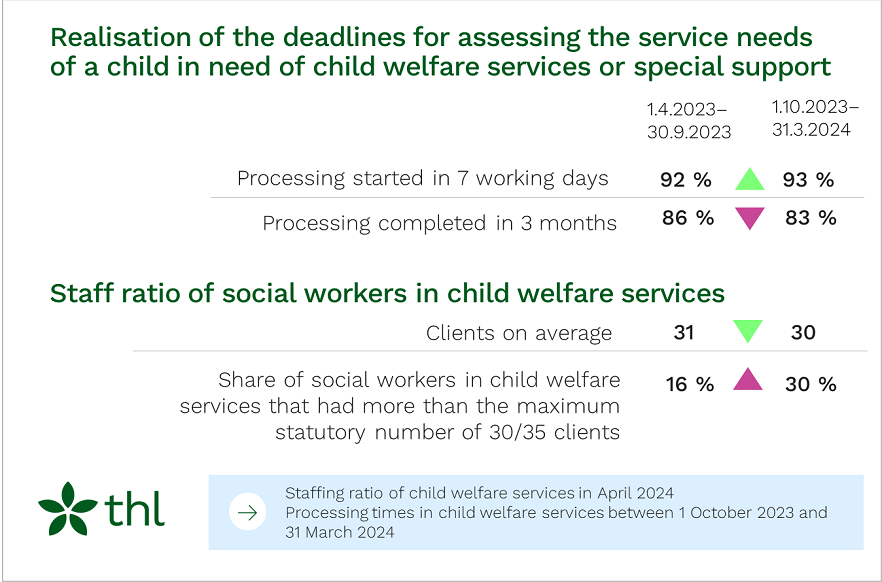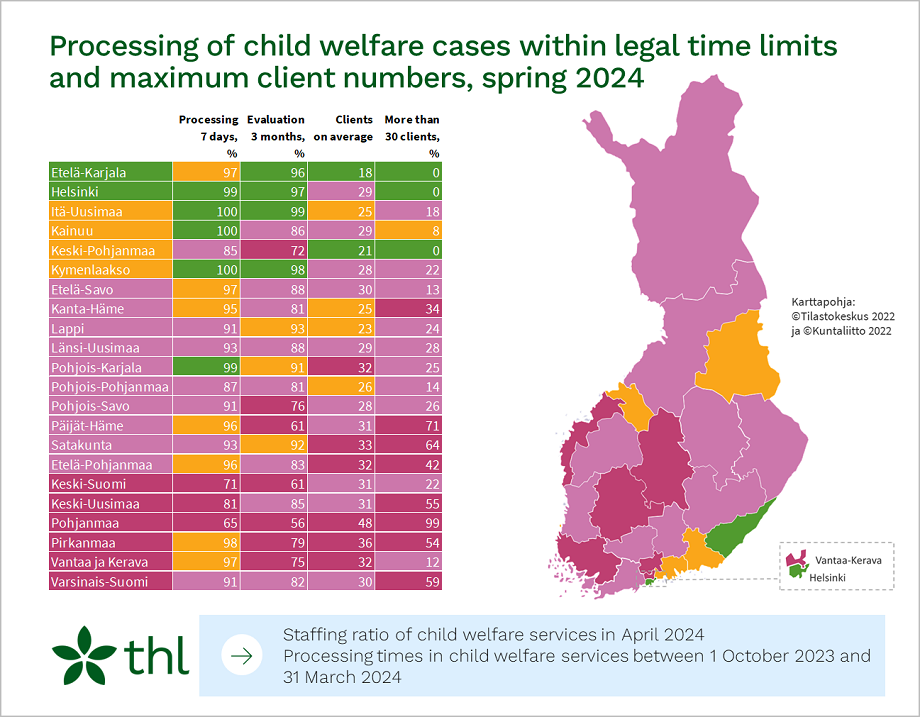Only South Karelia and Helsinki meet legal standards for the provision of child welfare services
As the latest statistics from the Finnish Institute for Health and Welfare show, only South Karelia and Helsinki are able to meet the legal standards for the provision of child welfare services. In the beginning of 2024, the staffing requirements of child welfare services were made stricter, limiting the number of children that one social worker can have as clients to 30. Previously, the number was 35.
Because of the stricter limit, fewer wellbeing services counties were able to comply with the law, even though the actual number of child welfare clients per social worker decreased in several regions.
“South Karelia and Helsinki were the only regions where, on the whole, child welfare services were provided in accordance with legal standards. However, we can only assess whether or not the minimum staff requirement is met and whether or not evaluations of service needs can be completed within three months,” says Martta Forsell, Development Manager at THL.
“While statistics provide a narrow window into the quality of child welfare services, they still show us that regions are unable to ensure that child welfare cases are processed within the legal time limits and maximum client numbers,” Forsell continues.
The information is based on THL’s statistics on the processing times and staffing ratios of child welfare services this year.

The situation is particularly concerning in Ostrobothnia
The situation in the wellbeing services county of Ostrobothnia has been particularly concerning this spring. Every social worker in child welfare services has more than the maximum number of clients. On average, there were as many as 48 clients per social worker. On the other hand, the statutory processing times were exceeded in up to a third of all client cases.
“The message we’ve received from Ostrobothnia is that they understand the severity of the situation. The region is trying to find long-term solutions by recruiting more qualified social workers and by avoiding the use of temporary agency workers.

Has the limit caused a queue to form in child welfare services?
“Under the current job description of a responsible social worker, 30 children is still a large number. The statutory limit has apparently reduced the number of actual excesses, and attention is now being paid to the number of clients, which is important, says Laura Yliruka, Development Manager at THL.
The flip side of the statutory limit is that, in some wellbeing services counties, not all children in need of child welfare services are assigned their own social worker right from the start. This kind of “queueing” can occur either before or after the need for child welfare services is officially determined, which is when a child becomes a client of child welfare services.
In April, THL investigated the practices of different regions. Around half of all regions were able to assign a social worker immediately. One third of the wellbeing services counties were occasionally forced to postpone the assignment of a responsible social worker.
In Central Finland, Vantaa-Kerava and Southwest Finland, clients typically had to wait to be assigned a social worker. The waiting periods varied from a few days to months. Assigning a social worker was prioritised based on how urgent the child’s situation was.
In Vantaa-Kerava, a special team has been set up to meet the needs of children waiting for an assigned social worker, while Central Finland is expanding similar services.
“In Southwest Finland, on the other hand, a social worker already handling more than the maximum number of clients is assigned as the responsible social worker where necessary. The process in Southwest Finland is more similar to that of other regions where the maximum number of clients per social worker is exceeded. Other regions like this include Päijät-Häme, Satakunta, Central Uusimaa and Pirkanmaa,” says Martta Forsell.
THL is working together with regions to improve the support available to families with children.
“Wellbeing services counties are facing a lot of challenges, but they are also making an effort to find sustainable solutions to support families with children. A national network for developing child welfare services was launched in the spring, and it aims to resolve the issues described earlier, such as the job descriptions and workload distribution of different child welfare professionals, as well as the bottleneck that limiting client numbers creates between child welfare services and family social work and any resulting issues," says Yliruka.
References
Child welfare - adequacy of personnel in social work in April 2024
Processing times in child welfare services between 1 October 2023 and 31 March 2024
Child welfare notifications filed for one out of six children aged 13 to 15 in 2023, numbers keep increasing
THL press release 2.5.2024
More information
Martta Forsell
Development Manager
tel. 029 524 7974
[email protected]
Laura Yliruka
Development Manager
tel. 029 524 7982
[email protected]



